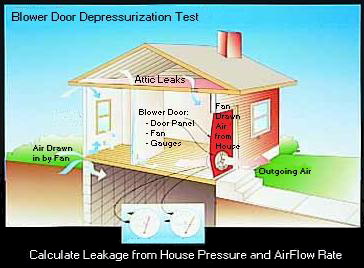There are several ways to find duct leakage:
- Using a duct leakage tester and blower door together (the most common method)
- Using a flow hood
- Using a blower door and pressure pan (for diagnostic purposes only)
- Using a blower door only (not recommended)
The basic idea behind using a duct leakage tester to test for duct leakage is:
- Use a calibrated fan to pressurize the duct system.
- Measure the airflow through the fan with the duct system at pressure.
Just as when you’re testing for airtightness, each cubic foot of air that leaks out (of the duct system in this case) must be made up by a cubic foot of air blown in by the fan. So, once you’ve measured the amount of air moving through the fan, you’ve quantified the duct leakage at the test pressure.

For duct leakage testing, the standard pressure used is 25 Pascals, which is close to the operating pressure of a typical duct system. This means that when we measure, say, 120 cubic feet per minute of duct leakage at 25 Pascals (written 120 cfm25), that number is a pretty good estimate of how much air leaks out of the duct system while it’s operating.
Going a little deeper now, there are two kinds of duct leaks – let’s call them benign and malignant. The malignant leaks are the ones we really care about. They’re the ones that send conditioned air into unconditioned spaces or suck unconditioned air into the system. Benign leaks are the ones leaking inside the conditioned space; they don’t exact an energy penalty.
Two kinds of duct leakage, of course, require two types of tests. The malignant leaks occur in ducts that are outside of the conditioned space, or outside the building envelope, in building science jargon, so the most important test is called the ‘outside leakage test’ or the ‘leakage outside the envelope test.’ The other test is not, as you might expect, the inside leakage test, but rather the total leakage test. Read more about these two tests by clicking the links below.
5 Steps for Keeping Water Out of the Holes in Your Walls
What you see in the photo above is common at construction sites. Once a house gets framed, the next step…
Allison Bailes provided excellent instruction in a class on performing home energy ratings. His lectures were well prepared and he responded well to the needs of the students. Allison has a strong knowledge in the area of home building and retrofitting with an emphasis on energy conservation and indoor air quality.

